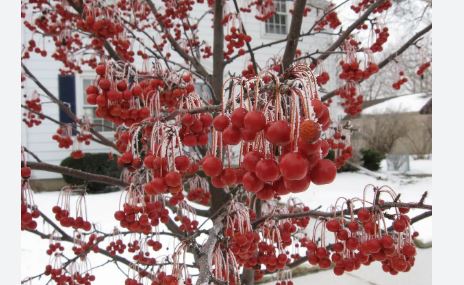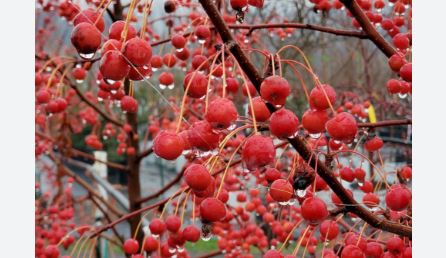
The Red Jewel Crabapple (Malus ‘Jewelcole’) is a captivating, disease-resistant ornamental tree prized for its profuse white spring blooms, brilliant red persistent fruit, and compact, upright form. As a standout cultivar in the Malus genus, this deciduous tree is a top choice for homeowners, landscapers, and urban planners seeking a low-maintenance tree with year-round appeal.
Botanical Classification
The Red Jewel Crabapple belongs to the following taxonomic classification:
- Kingdom: Plantae
- Phylum: Tracheophyta
- Class: Magnoliopsida
- Order: Rosales
- Family: Rosaceae
- Genus: Malus
- Cultivar: ‘Jewelcole’ (Red Jewel™)
The Malus genus encompasses both apples and crabapples, with crabapples defined by their smaller fruit (less than 2 inches in diameter). The Red Jewel Crabapple, registered as Malus ‘Jewelcole’ and trademarked as Red Jewel™, is a hybrid cultivar bred for its ornamental qualities, disease resistance, and persistent fruit. Its hybrid nature, likely derived from species like Malus baccata or Malus floribunda, makes it a versatile addition to the Rosaceae family.
History of the Red Jewel Crabapple
The Red Jewel Crabapple was introduced by J. Frank Schmidt & Son Co., a prominent nursery in Oregon, known for developing high-quality ornamental trees. While the exact origin and breeding details are not widely documented, it emerged as a selected cultivar in the late 20th century, valued for its compact size, profuse white flowers, and vibrant red fruit that persists into winter.
The cultivar’s name, ‘Jewelcole,’ reflects its jewel-like red fruits, which are among the most profuse and persistent of any crabapple, making it a standout in landscaping. Its development focused on improving disease resistance and suitability for urban environments, earning it recognition from the Ornamental Crabapple Society for street tree and urban use.
Crabapples trace their origins to the mountainous regions of Central Asia, particularly Kazakhstan, where the wild apple species Malus sieversii is considered the ancestor of modern apples and crabapples. These trees spread across Europe and Asia via the Silk Road and were introduced to North America by European colonists in the 17th century for cider production and ornamental purposes.
Native North American crabapple species, such as Malus coronaria (sweet crabapple) and Malus fusca (Pacific crabapple), also contributed to the genetic diversity of cultivated crabapples. The Red Jewel Crabapple builds on this legacy, combining modern breeding techniques with the hardy traits of its ancestors to create a reliable, visually striking tree.
Native Area
As a cultivated hybrid, the Red Jewel Crabapple does not have a true native range but is derived from Malus species native to temperate regions of the Northern Hemisphere, including Central Asia (e.g., Kazakhstan, Russia, and China) and parts of North America.
Its likely ancestors include Malus baccata (Siberian crabapple) and Malus floribunda (Japanese flowering crabapple), both native to Asia, as well as native North American species like Malus coronaria (eastern U.S.) and Malus fusca (Pacific Northwest and Alaska). Developed in the United States, the Red Jewel Crabapple is widely adaptable, thriving in urban and rural landscapes across North America and other temperate regions.
Identifying Characteristics

The Red Jewel Crabapple is renowned for its compact form, vibrant seasonal displays, and four-season interest.
- Size and Shape: This small deciduous tree grows to a height of 12–15 feet with a spread of 8–12 feet, forming an upright, pyramidal to oval crown. Its compact size and low canopy (clearance of 3–4 feet) make it ideal for small gardens, patios, or urban settings.
- Foliage: The leaves are simple, ovate to elliptical, 2–3 inches long, with serrated margins. They emerge medium green in spring, maturing to glossy dark green in summer, and turn yellow to gold in fall, providing a warm contrast to the red fruit.
- Flowers: In mid spring (April–May), the tree produces profuse single, white flowers (1–1.5 inches across) that open from pink to red buds. The fragrant blooms cover the branches from base to tip, creating a stunning display and attracting pollinators like honeybees, bumblebees, mason bees, and butterflies.
- Fruit: Following the blooms, the tree develops clusters of bright red, berry-like pomes (1/2 inch in diameter), which ripen in late summer (August–September) and persist into late winter or early spring (February–March). These glossy, cherry-red fruits darken and shrivel as winter progresses, adding vibrant winter interest. The fruits are notably hard and unpalatable to birds, enhancing their persistence.
- Bark: The bark is greyish-brown, smooth when young, and becomes slightly scaly or cracked with age. It provides subtle texture to the winter silhouette.
- Growth Habit: The tree’s upright, pyramidal to oval form, with dense, twiggy branching, creates a tidy, formal appearance. Its low branching requires occasional pruning to ensure clearance for pedestrians or vehicles when used as a street tree.
Uses of the Red Jewel Crabapple
The Red Jewel Crabapple is primarily an ornamental tree, valued for its aesthetic appeal, ecological benefits, and versatility in urban and residential landscapes. Its uses include:
- Landscaping: The tree’s compact size, profuse white blooms, and persistent red fruit make it ideal for specimen planting, accent trees, patio trees, street trees, or group plantings. Its upright, pyramidal form suits small gardens, urban courtyards, parking lot islands, or planting under power lines. It pairs beautifully with evergreens like holly or yew, where its red fruit stands out in fall and winter.
- Wildlife Support: The fragrant flowers attract pollinators like honeybees, bumblebees, mason bees, sweat bees, and butterflies, supporting early-season pollination. The persistent fruits are not favored by birds due to their hard texture, providing extended winter interest for humans rather than wildlife. However, some birds (e.g., starlings) may consume the fruits in late winter after frost softens them.
- Culinary Uses: The small, tart fruits are generally unpalatable raw but can be used to make jellies, preserves, sauces, or cider due to their high pectin content. Their vibrant red color adds visual appeal to culinary products, though they are less commonly used compared to juicier crabapple varieties like Dolgo or Centennial.
- Pollination: The Red Jewel Crabapple is self-sterile, requiring cross-pollination with another Malus cultivar (e.g., another crabapple or apple tree) blooming simultaneously to produce fruit. Its abundant pollen makes it an excellent pollinator for self-sterile apple trees, enhancing fruit yields in home orchards.
- Urban and Commercial Use: Its high tolerance for urban pollution, drought, poor drainage, and compacted soils makes it a top choice for city parks, parking lot islands, streetscapes, or sidewalk cutouts. It is recommended by the Ornamental Crabapple Society for urban use, particularly when grafted onto EMLA 106 or 111 rootstocks to reduce suckering.
- Bonsai and Espalier: The tree’s compact size and attractive branching make it suitable for bonsai or espalier training, adding artistic flair to small gardens or patios.
- Medicinal and Traditional Uses: Historically, crabapple fruits and bark have been used in traditional medicine by Indigenous peoples for digestive issues or gout relief due to their malic and tartaric acid content. While not a primary use for Red Jewel, its fruits share these properties.
Growth Rate
The Red Jewel Crabapple has a slow to moderate growth rate, adding 10–12 inches per year under optimal conditions. It reaches flowering and fruiting maturity within 3–5 years and achieves its mature height of 12–15 feet in approximately 10–15 years. Its compact size and slow growth make it ideal for small spaces, and its lifespan can reach 30–50 years with proper care.
USDA Hardiness Zones
The Red Jewel Crabapple thrives in USDA Hardiness Zones 4–8, tolerating winter temperatures as low as -30°F and performing well in warm, temperate summers. It requires 500–600 chill hours (hours below 45°F) to break dormancy and set fruit, making it less suited for very warm climates like USDA Zone 9b or higher.
The tree prefers full sun (6+ hours daily) to maximize flowering, fruiting, and foliage health, but it tolerates partial shade with reduced bloom and fruit production. It grows best in moderately rich, well-drained, slightly acidic soils (pH 5.0–6.8) but adapts to a wide range of soil types, including clay, loam, and sandy soils. Once established, it is drought-tolerant, pollution-resistant, and somewhat tolerant of salt spray, making it suitable for urban and coastal plantings.
Fun Fact
The Red Jewel Crabapple’s bright red fruits are so persistent that they often remain on the tree until spring, when they are replaced by a fresh flush of white blooms, creating a seamless transition of color. Unlike many crabapples, its fruits are notably unpalatable to birds, ensuring a long-lasting display that earned it the nickname “the jewel of winter” among gardeners. This unique trait makes it a favorite for adding vibrant winter interest to landscapes.
Care and Maintenance Tips
To ensure the Red Jewel Crabapple thrives, follow these care tips:
- Planting: Choose a sunny, well-drained site with good air circulation to minimize disease. Dig a hole twice as wide and as deep as the root ball, incorporating compost to enrich slightly acidic soil. Plant in spring or fall, ensuring the root ball’s top is level with the ground. Water deeply and apply a 2–3-inch layer of organic mulch (e.g., wood chips), keeping it away from the trunk to prevent rot. Space plants 10–20 feet apart to accommodate mature size.
- Watering: Water regularly (weekly, 12–15 gallons) during the first year to establish roots, using the “finger test” (water if soil is dry 2 inches down). Once established, water during prolonged dry spells or extreme heat. Avoid overwatering to prevent root rot.
- Pruning: Prune in late winter or early spring before bud break to remove dead, diseased, or crossing branches, water sprouts, and suckers. For street trees, remove lower branches to ensure pedestrian and vehicular clearance. Minimal pruning is needed to maintain its pyramidal form. Sanitize tools between cuts to prevent disease spread.
- Fertilization: If planted in fertile soil, fertilization is rarely needed. In poor soils, apply a slow-release, balanced fertilizer (e.g., 10-10-10) or compost in early spring before growth begins. Avoid over-fertilizing, as excess nitrogen can increase disease susceptibility.
- Pest and Disease Control: The Red Jewel Crabapple has good resistance to apple scab, cedar-apple rust, and powdery mildew but is fairly susceptible to fire blight. Monitor for minor pests like aphids, fall webworms, scales, or spider mites, which can be managed with horticultural soap, Bacillus thuringiensis, or beneficial insects like ladybugs. Avoid planting near junipers, which host cedar-apple rust.
- Site Selection: Plant 10–15 feet from walkways, driveways, or patios to avoid fruit drop mess. Ensure good air circulation to reduce disease risk. Avoid planting near black walnut trees, as crabapples are intolerant of juglone.
Challenges and Considerations
While the Red Jewel Crabapple is low-maintenance, consider the following:
- Fruit Drop: The persistent fruits may drop in late winter or early spring, requiring cleanup in high-traffic areas like sidewalks or driveways. Avoid planting directly adjacent to these areas. The fruits are toxic to pets if ingested in large quantities, so supervise pets during drop season.
- Fire Blight Susceptibility: The tree is fairly susceptible to fire blight, particularly in humid, wet conditions. Proper pruning, good air circulation, and avoiding high-nitrogen fertilizers reduce risks.
- Pollination Requirements: As a self-sterile tree, it requires a nearby Malus cultivar (e.g., another crabapple or apple tree) blooming simultaneously for fruit production. Ensure a compatible pollinator is within 50–100 feet.
- Seed Toxicity: Like all Malus species, the seeds contain trace amounts of amygdalin, which can break down into cyanide if crushed and ingested in large quantities. The risk is minimal, as the tart fruits are not typically consumed raw, and whole seeds pass through the digestive system harmlessly.